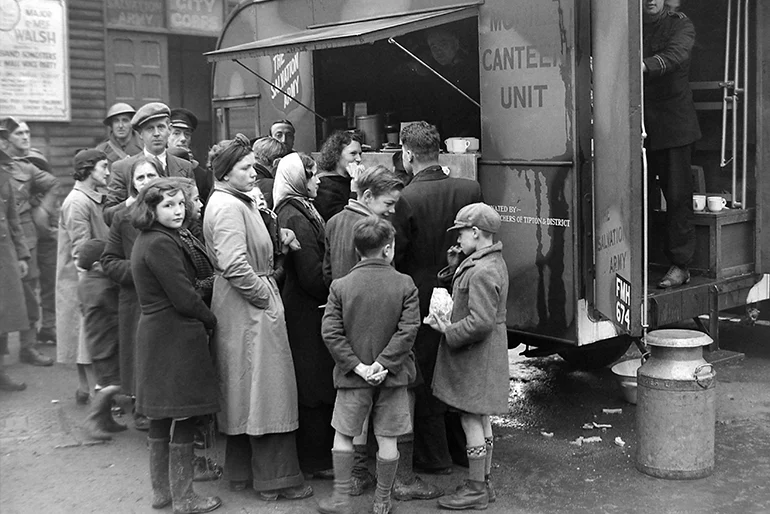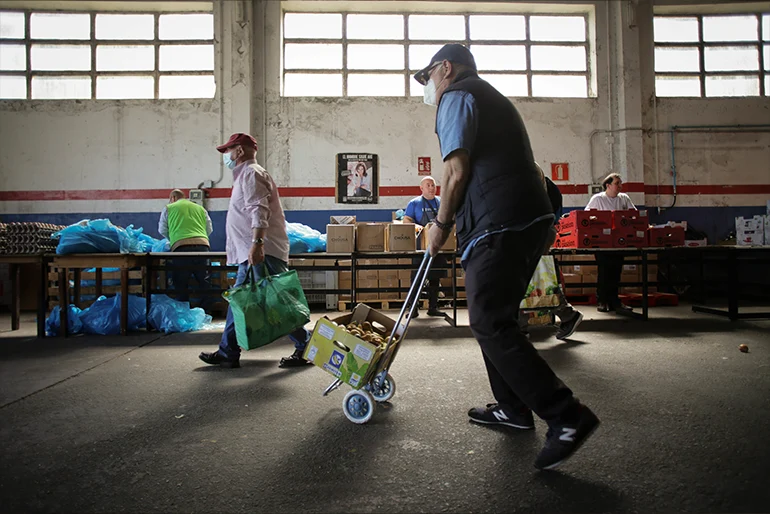Feeding the Future: The Role of Food Banks
Food banks are charitable organisations that distribute free food to individuals in need. Unlike government food assistance programs, which provide citizens with money or vouchers to purchase food, food banks distribute the food directly. Food banks are typically intermediate agents that connect donors (of food or money) and beneficiaries who are in need of food aid. Depending on their approach, food banks may provide services such as purchasing or transporting food, renting premises to sort, clean, and store food, and preparing meals or grocery parcels. They may be funded by public or private organisations or a combination of the two and can be managed by a variety of private actors such as faith-based organisations and NGOs or may even be run by community members acting as volunteers. While some food banks deliver tonnes of food each year, others may be as small and simple as a fridge set up in a community centre.
Soup kitchens versus food pantries
There are two major types of food banks: soup kitchens and food pantries.* Charitable organisations serving meals for on-site consumption are often called soup kitchens, but they may also be referred to as social restaurants, social cafés, or community kitchens. Soup kitchens provide freshly prepared meals and facilitate social interaction among individuals who experience exclusion because of their socioeconomic status. They may prepare meals once or twice a day or on specific days of the week.
The soup kitchen "Casa del Pueblo La Dignidad" in Buenos Aires, Argentina, provides meals to over 150 people every day, underscoring the increasing dependence on community food assistance as the nation grapples with skyrocketing inflation. This economic turmoil has forced many families to turn to initiatives like this for essential nourishment, emphasizing the critical role such establishments play in aiding vulnerable communities.
Unlike soup kitchens, food pantries concentrate on supplying households with groceries for preparing meals at home. Depending on the pantry's approach, clients might receive pre-packed food boxes or choose items themselves. Given their larger operational scope, food pantries frequently engage in regional collaborations, working with nearby pantries or joining extensive networks to pool resources such as food supplies, logistics, and volunteer efforts. These partnerships allow them to enhance their reach, ensuring effective distribution and consistent access to those who need it most. Unlike soup kitchens, food pantries concentrate on supplying households with groceries for preparing meals at home. Depending on the pantry's approach, clients might receive pre-packed food boxes or choose items themselves. Given their larger operational scope, food pantries frequently engage in regional collaborations, working with nearby pantries or joining extensive networks to pool resources such as food supplies, logistics
, and volunteer efforts. These partnerships allow them to enhance their reach, ensuring effective distribution and consistent access to those who need it most.
Using surplus food to prevent hunger
Within the retail and manufacturing phases of the food supply chain, a significant portion of food remains unsold due to factors such as misprinted labels, overproduction, or damaged packaging. Despite being safe for consumption, these items cannot be marketed due to strict regulatory standards, leaving businesses to navigate alternatives to waste. Many companies choose to donate such surplus to food banks, framing it as a socially responsible practice. In countries like France and Italy, this act is not merely voluntary but legally mandated, requiring supermarkets to redirect unsold goods to food banks. However, critics argue that relying on marginalized communities to consume surplus or imperfect products raises ethical concerns—questioning whether this practice addresses systemic inequities or merely shifts the burden of corporate excess onto vulnerable populations.
Do food banks provide healthy food?
Dependent on donated goods, food banks often lack control over the types of food they receive, leading to difficulties in providing beneficiaries with nutritionally balanced meals or parcels. Research highlights that perishable yet nutritionally critical items such as fruits, vegetables, dairy products, and meat are frequently absent due to food safety concerns and the high costs of refrigeration and transportation. A study in the Netherlands demonstrated that calorie-dense foods like pastries, cookies, and savory snacks are consistently included in food bank parcels, whereas healthier options like legumes , fish, and ready-to-eat vegetarian products remain scarce. This imbalance underscores systemic challenges in ensuring equitable access to nutritious food for marginalized communities.
How do beneficiaries feel about using food banks?
While accessing free food through food banks may seem like a practical solution for those in need, research reveals that many users perceive the experience as deeply distressing. Studies indicate that food bank recipients often feel shame or embarrassment about relying on such aid, viewing it as a last resort rather than a voluntary choice. In the UK, beneficiaries frequently express distress over the social stigma attached to using food banks, fearing judgment from their communities as failures (Middleton et al., 2018). Similarly, a study on food insecurity in the UK highlights how individuals grapple with feelings of embarrassment, perceiving food bank use as a mark of personal inadequacy (Purdam et al., 2016). In the Netherlands, users report dissatisfaction with the nutritional quality of donated goods, criticizing parcels for containing unhealthy or spoiled items. As noted in one study, recipients feel “the food bank, as well as society as a whole, gives them food that would otherwise have been given to pigs” (Van der Horst et al., 2014, p. X), reflecting broader concerns about dignity and respect. To address these issues, some countries like the Netherlands are piloting self-service models, allowing recipients to select items from pantry-style aisles, aiming to restore agency and reduce the stigma associated with standardized parcel distributions.
Who are the people using food banks?
Food banks are typically used by people who struggle to regularly access sufficient quantities of safe and affordable food. A combination of complex societal and economic factors creates these circumstances, making it difficult to create a profile for the average food bank user. However, based on statistics from some European countries, we know that single-parent households, refugees, disabled individuals, former convicts, unemployed persons, and the elderly are especially vulnerable to food insecurity and may thus seek support from their local food banks.
Are food banks here to stay?
Some researchers believe that the increasingly prominent presence of food banks in high-income countries indicates that the government is failing to fulfil its duty to citizens. Others believe that food banks play an important complementary role to State-sponsored welfare programmes and allow citizens and businesses to make a meaningful contribution to society. The role of food banks in our society is especially highlighted during crises. For instance, during the COVID-19 pandemic, food charities were critical in providing aid to the most severely affected members of society. Many went to great lengths to continue operating despite lockdown measures and supply chain disruptions. However, the current system of food banking may not be sustainable in the long term due to its reliance on surplus food. In the future, technological innovations are likely to make food production more efficient than it currently is, and this, in turn, will leave food businesses with fewer kilos of surplus food. Food banks of the future must recognise their roles as temporary solutions to the systemic problem of food insecurity and work together with other actors in the food system to make sure that everyone has equal access to safe and nutritious food in sufficient quantities.
About author
SS Engineers and Consultants is a premier engineering firm specializing in innovative design solutions, sustainable practices, and comprehensive project management. With decades of combined experience across various industries, their team of expert engineers and consultants delivers tailored services that meet the unique needs of each client, ensuring safety, efficiency, and cost-effectiveness in every project.
This line emphasizes their professionalism, expertise, and commitment to delivering high-quality results. If necessary, adjustments can be made based on specific areas of focus or achievements!








Comments
Post a Comment